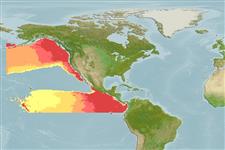>
Lophiiformes (Anglerfishes) >
Oneirodidae (Dreamers)
Etymology: Oneirodes: Greek, 'oneiros' = a dream or dreamlike or out of a dream (suggesting this fish is so strange and marvelous that can exist only in dreams) (Ref. 86949).
Environment: milieu / climate zone / depth range / distribution range
Ecologia
marinhas batipelágico; intervalo de profundidade 700 - 1400 m (Ref. 86949). Deep-water
Eastern Central Pacific: Mexico.
Tamanho / Peso / Idade
Maturity: Lm ? range ? - ? cm
Max length : 15.9 cm SL (female)
Descrição breve
Morfologia | Morfometria
Raios dorsais moles (total): 5-6; Raios anais moles: 4. Characterized by having escal morphology: esca with filamentous, branched anterior appendage two times length of escal bulb, without internal pigment; presence of spots of dark pigment on most branches of anterior appendage; absence of medial escal appendage; rounded or conical terminal escal papilla with two bilaterally placed distal spots of pigment; posterior escal appendage, as long as escal bulb, with an anteroposteriorly compressed distal end, posterior surface of which is slightly concave and darkly pigmented; absence of lateral escal appendage; two pairs of filamentous anterolateral escal appendages; inner pair of branched tapering appendages flanking anterior appendage, each less than one-half length of escal bulb; long and narrow subopercle, dorsal end tapering to a point, without indentation on posterodorsal margin; length of ventral fork of opercle 25.3-28.6% SL; ratio of lengths of the dorsal and ventral forks of opercle 0.54-0.62; absence of epibranchial teeth; presence of teeth on pharyngobranchial II; upper jaw teeth 49-69, lower jaw teeth 46-60; teeth on vomer 4-8; dorsal fin rays 5-6; anal fin rays 4; pectoral fin rays 15-16; head length 38.9-43.4% SL; head depth 37.7-41.7% SL; premaxilla length 32.2-33.3% SL; length of lower jaw 42.1-44.3% SL; length of illicium 45.9-51.6% SL (Ref. 86949).
Life cycle and mating behavior
Maturidade | Reprodução | Desova | Ovos | Fecundidade | Larvas
Orr, J.W., 1991. A new species of the ceratioid anglerfish genus Oneirodes (Oneirodidae) from the western North Atlantic, with a revised key to the genus. Copeia 1991(4):1024-1031. (Ref. 36336)
Categoria na Lista Vermelha da IUCN (Ref. 130435)
Ameaça para o homem
Harmless
Utilização humana
Mais informação
Nomes comunsSinónimosMetabolismoPredadoresEcotoxicologiaReproduçãoMaturidadeDesovaAgregação para desovaFecundidadeOvosDesenvolvimento dos ovos
Idade/TamanhoCrescimentoComprimento-pesoComprimento-comprimentoFrequência de comprimentoMorfometriaMorfologiaLarvasDinâmica larvarRecrutamentoAbundânciaBRUVS
ReferênciasAquaculturaPerfil para aquaculturaEstirpesGenéticaElectrophoresesHereditariedadeDoençasProcessamentoNutrientsMass conversion
ColaboradoresFotografiasStamps, Coins Misc.SonsCiguateraVelocidadeTipo de nataçãoÁrea branquialOutras referênciasCérebrosVisão
Ferramentas
Relatórios especiais
Descarregue XML
Fontes da internet
Estimates based on models
Preferred temperature (Ref.
123201): 3.3 - 4.1, mean 3.7 °C (based on 16 cells).
Phylogenetic diversity index (Ref.
82804): PD
50 = 0.5000 [Uniqueness, from 0.5 = low to 2.0 = high].
Bayesian length-weight: a=0.01995 (0.00906 - 0.04395), b=3.01 (2.83 - 3.19), in cm total length, based on all LWR estimates for this body shape (Ref.
93245).
Nível Trófico (Ref.
69278): 4.2 ±0.7 se; based on size and trophs of closest relatives
Resiliência (Ref.
120179): Médio, tempo mínimo de duplicação da população 1,4 - 4,4 anos (Preliminary K or Fecundity.).
Fishing Vulnerability (Ref.
59153): Low vulnerability (10 of 100).
